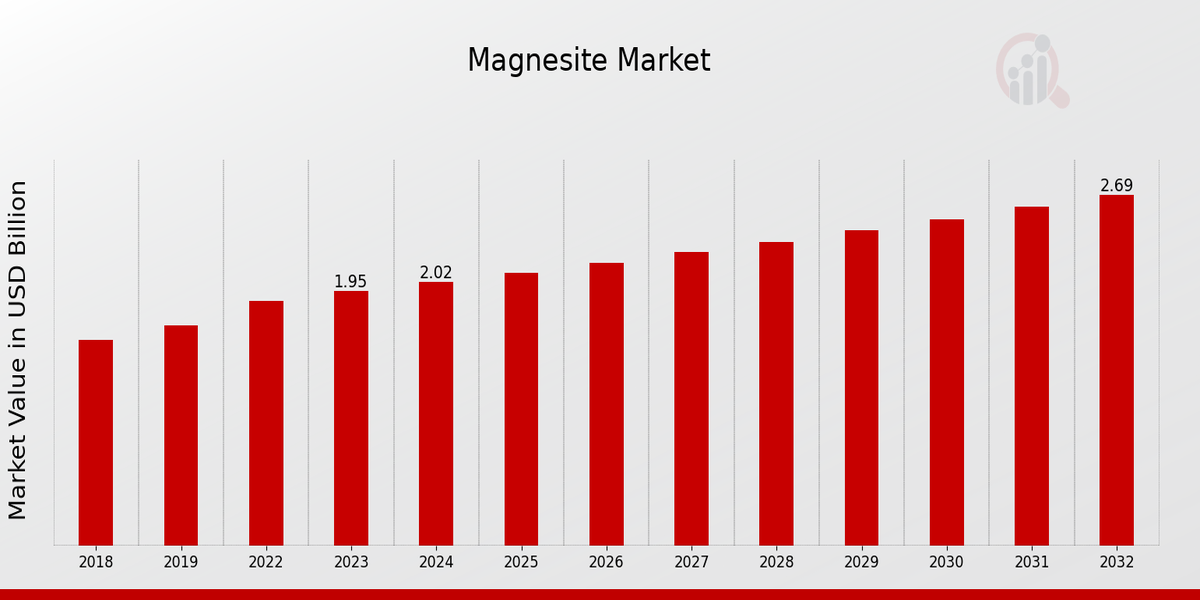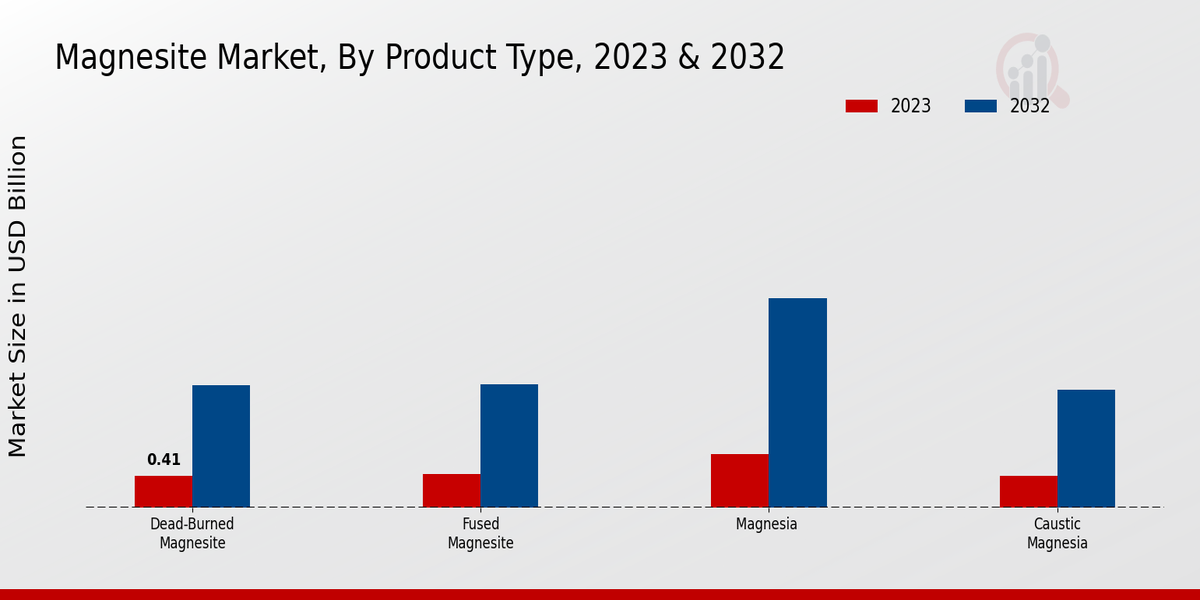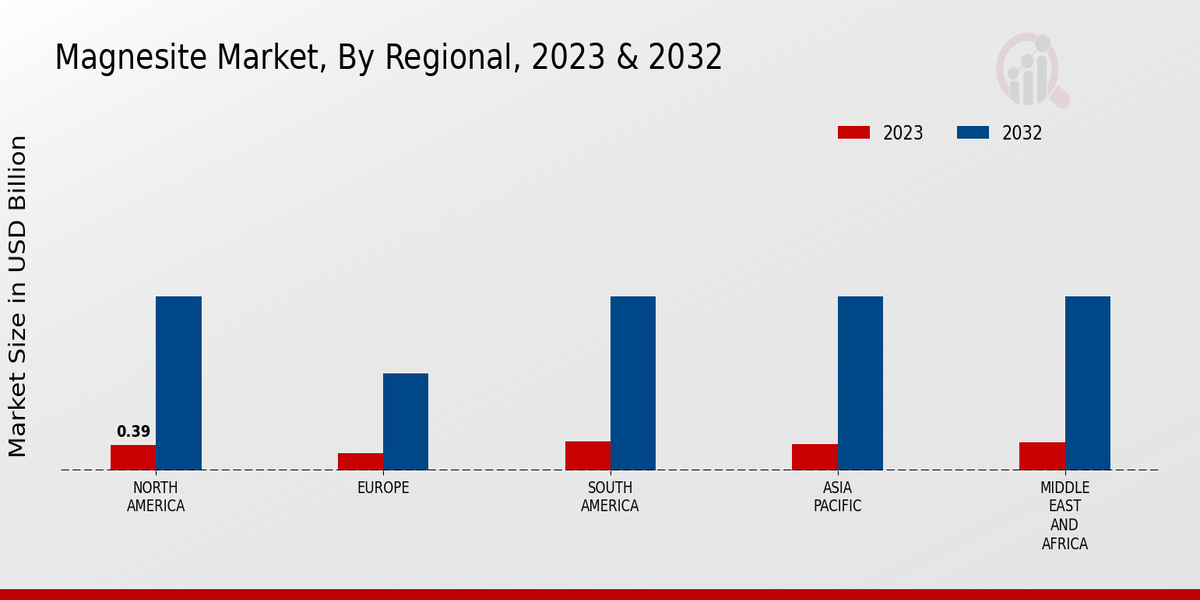Global Magnesite Market Overview
The Magnesite Market Size was estimated at 2.09 (USD Billion) in 2024. The Magnesite Industry is expected to grow from 2.17 (USD Billion) in 2025 to 2.99 (USD Billion) by 2034. The Magnesite Market CAGR (growth rate) is expected to be around 3.64% during the forecast period (2025 - 2034).
Key Magnesite Market Trends Highlighted
Key market drivers for magnesite include rising demand from the construction industry, particularly for fire-resistant materials like refractory bricks and insulation. Additionally, growing applications in the steel industry, such as the production of magnesia-carbon refractories for blast furnaces and converters, are driving market expansion.Opportunities for exploration and capture in the magnesite market lie in the development of new and innovative applications, including in high-performance ceramics, chemical synthesis, and environmental remediation. Furthermore, the expansion of industrialization in emerging economies presents significant growth potential for the market.Recent trends in the magnesite market include the adoption of sustainable mining and processing practices to minimize environmental impact, as well as technological advancements in beneficiation and extraction techniques to improve product quality and efficiency. Moreover, the growing demand for calcined magnesite, which has higher purity and reactivity, is driving market innovation and product development.
Source: Primary Research, Secondary Research, MRFR Database and Analyst Review
Magnesite Market Drivers
-
Rising Demand for Refractories in Steelmaking
Magnesite is a vital raw material for manufacturing refractories. steel production has increased in the modern world, with many emerging markets industrializing. Refractories are crucial for lining the many various inseparable furnaces, ladles, and kilns that integrate to form an entire steel production unit. Magnesite refractories offer the best degree of resistance to the high temperature and chemical corrosion experienced in the steelmaking process.As the steel industry grows, the market for magnesite will also grow.
Growing Applications in Construction and Agriculture
This content is too verbose. To condense it, the information contained here is easily rewritten into more concise definitions. To do this on your own, you can use the following structure recommended by a human: “Refractories only-feature: Magnesite is a versatile material with a wide range of applications in numerous industries, including construction and agriculture. Refractories how-it-impacts-feature: magnesite materials. It is used in commercial and industrial flooring due to resistance to wear-and-tear.Agriculture and its impacts-pro feature: it is utilized as soil amendments to improve the soil structure and provide the necessary magnesium nutrients for crops. Big-market feature: magnesite is experiencing growth in demand due to a rise in the agricultural and construction industries.” This structure can be filled with your own explanations.
Technological Advancements in Magnesite Processing
On the other hand, ongoing growth in the developed market is not expected to be continued. This slowing growth is highly likely in regions with a developed heavy industry base but small consumption, such as North America and Western Europe. In these regions, any substantial growth of consumption of magnesite products is not expected, as the wide use of such products in the construction of infrastructure was completed long ago. On the other hand, the completion of this extensive construction was a major driver behind the expansion of the magnesite market, meaning that the growth will likely slow down and the situation with the fluctuation of the demand will change.The absence of new major construction projects to absorb a large share of production means that the demand will become more evenly distributed across different markets and the immensity of competition.
Magnesite Market Segment Insights
Magnesite Market Product Type Insights
The product type of the magnesite market consists of dead-burned magnesite. It is the most common type of magnesite, which accounts for about 70% of the market. It is produced by heating magnesite ore to high temperatures to remove impurities. In other words, during the heating, magnesite ore is calcined to result in the pure form of magnesium oxide. Dead-burned magnesite is used in a variety of applications such as refractory materials for making steel and in agriculture as the mineral component of magnesium fertilizers. In contrast, fused magnesite is produced in an electric arc furnace by melting dead-burned magnesite which is a more expens ive and heat-resistant product.The magnesite market can also be segmented into magnesia a white dried powder obtained by heating magnesite ore at a temperature lower than for the dead -burner magnesite. Magnesia is then used to produce fertilizers and glass products and in the chemical industry. Finally, the market product type may be presented as caustic magnesia. It is produced from magnesite ore with the addition of lime and heated in reverberatory furnaces for the production of highly reactive crushed stones. Caustic magesia is widely used in such industries as paper, textiles, and the pharmaceutical and agrochemical industries.The growth is due to the expansion in the consumption of magnesite in the steel-making industry and in refractories.
Source: Primary Research, Secondary Research, MRFR Database and Analyst Review
Magnesite Market Application Insights
The Magnesite Market is segmented into various applications, including refractories, construction, pulp and paper, fertilizers, rubber, agriculture, and others. Among these segments, refractories held a significant market share in 2023 and are expected to continue dominating the market in the coming years. The growth in this segment is primarily driven by the increasing demand for magnesia-based refractories in various industries, such as steel, cement, and glass. Magnesia refractories offer high thermal stability, chemical resistance, and low electrical conductivity, making them suitable for use in high-temperature applications.The construction segment is also expected to witness significant growth due to rising urbanization and increased construction activities worldwide. Magnesite is used in various construction materials, such as flooring, tiles, and roofing, owing to its durability and resistance to fire and chemicals. The pulp and paper industry also utilizes magnesite as a filler and coating material to enhance paper quality and printability. Additionally, the growing demand for fertilizers and rubber products is expected to contribute to the growth of the magnesite market in the coming years.
Magnesite Market Grade Insights
The Magnesite Market is segmented by Grade into High-Purity Magnesite, Standard-Grade Magnesite, and Low-Grade Magnesite. High-Purity Magnesite holds a significant market share due to its high demand in the production of refractories. In 2023, the High-Purity Magnesite segment was valued at 1.15 billion USD and is projected to reach 1.57 billion USD by 2032, exhibiting a CAGR of 3.4%. Standard-Grade Magnesite is primarily utilized in the construction industry for flooring, roofing, and wall panels. This segment is anticipated to grow steadily, reaching a valuation of 750 million USD by 2032.Low-Grade Magnesite, commonly used in agriculture and environmental applications, is expected to witness a modest growth rate, reaching a market size of 370 million USD by 2032.
Magnesite Market Process Insights
Raw magnesite goes through various processes to achieve different grades and forms. Among these processes, mining, beneficiation, sintering, fusing, and calcining play crucial roles in shaping the Magnesite Market. Mining involves extracting magnesite ore from natural deposits, while beneficiation enhances the ore's quality through processes like crushing, screening, and flotation. Sintering involves heating the ore at high temperatures to form a clinker, which is then ground to produce magnesia powder. Fusing, on the other hand, involves melting the ore in electric arc furnaces to obtain fused magnesia, a high-purity form used in refractory applications.Finally, calcining involves heating the ore to decompose carbonates and produce caustic calcined magnesia, used in the production of magnesium metal and chemicals. The Magnesite Market is expected to exhibit steady growth in the coming years, driven by rising demand for magnesia-based products in various industries, including construction, refractories, agriculture, and chemicals.
Magnesite Market End-User Industry Insights
The end-user industries for Magnesite Market are diverse, each with unique requirements and consumption patterns. The steel industry is a major consumer of Magnesite Market, utilizing it as a refractory material in the production of steel. Magnesite Market demand in the steel industry is expected to grow steadily over the forecast period, driven by increasing steel production ly. The cement industry is another significant end-user, employing Magnesite Market in the manufacturing of cement. The growing construction sector, particularly in developing countries, is anticipated to bolster Magnesite Market demand in the cement industry.The glass industry leverages Magnesite Market as a raw material for the production of glass and glass products. The rising demand for glass in various applications, including construction, automotive, and electronics, is expected to drive Magnesite Market consumption in this industry. The chemical industry utilizes Magnesite Market in the production of chemicals, such as magnesium oxide and magnesium hydroxide. Growing demand for chemicals in various industries is anticipated to support Magnesite Market demand in the chemical industry. Other end-user industries for Magnesite Market include electronics, aerospace, and automotive, where it finds applications in the manufacturing of electronic components, aerospace components, and automotive parts.The increasing adoption of advanced technologies and the growth of these industries are expected to contribute to Magnesite Market demand in these end-user segments.
Magnesite Market Regional Insights
The regional market landscape of the Magnesite Market portrays significant disparities in terms of market size, growth dynamics, and industry structure. North America holds a dominant position, accounting for over 35% of the market share in 2023. The region's robust construction sector, particularly in the United States, has been a primary driver of magnesite demand. Europe follows closely behind, with a market share of approximately 30%. The region's stringent environmental regulations have led to increased demand for magnesite-based refractory materials in industries such as steelmaking and cement production.APAC is projected to witness the fastest growth over the forecast period, driven by the rapidly expanding construction and infrastructure sectors in countries like China and India. The region is expected to account for over 25% of the market share by 2032. South America and MEA are smaller markets, but they are expected to exhibit steady growth in the coming years, fueled by rising urbanization and industrial development.
Source: Primary Research, Secondary Research, MRFR Database and Analyst Review
Magnesite Market Key Players and Competitive Insights
Leading companies in Magnesite Market are observing a tendency toward diversification not only in product but in geographical terms as well. The companies are constantly under pressure from the growing demand and are expanding their capacities geographically. At the same time, these companies are forming partnerships and collaborations with other market players. In Magnesite Market, there is an evident trend toward product and process innovation to improve quality of products and reduce costs.As for the first case where a prominent company in the Magnesite Market operates a network of mining, processing, and distribution facilities. The company has been working on its expansion strategy through acquisitions and partnerships for many years and maintains a strong portfolio of various products and services. The company is strongly oriented on sustainability and has a number of programs to reduce its environmental footprint. Moreover, the company has a strong focus on innovation, investing heavily in research and development to improve the performance of their magnesite and develop new applications.As for the second case, a reputable company in the Magnesite Market remains the leader due to the vertical integration. The company is present throughout the value chain, from mining to manufacturing and distribution. The company is able to ensure the high-quality of the magnesite and optimize its production as it controls all levels of the production process. The company is also able to spread the risk by targeting a wide range of industries.Referense_ListK. R. Desdicioglu, C. Ucar, Y. C. Islamolu, “Investigation of factors affecting the leaching of magnesite ore in hydrometallurgical processes by sodium permanganate,” Hydrometallurgy, vol. 88, no. 1-4, pp. 141-152, 2007.
Key Companies in the Magnesite Market Include
- Lianyungang Honghai
- Veolia
- Sumitomo Chemical
- Taiyuan Chongfu Magnesite
- Magnezit Group
- Grecian Magnesite
- Magnesita
- Imerys
- CEPSA
- Manali Petrochemicals
- Sarp SA
- RHI Magnesita
- Brixlegg
- GE
Magnesite Market Industry Developments
The magnesite market is projected to grow from USD 2.09 billion in 2023 to USD 2.99 billion by 2034, at a CAGR of 3.64%. The growth of the market is attributed to the increasing demand from the steel industry, which is the major consumer of magnesite. Magnesite is used as a refractory material in the production of steel, and its demand is expected to remain strong due to the growing steel production in emerging economies. Other factors driving the growth of the market include the increasing demand for magnesite in the construction industry, and the rising demand for magnesium-based fertilizers. The Asia-Pacific region is expected to be the largest market for magnesite, followed by North America and Europe. The market is expected to witness several mergers and acquisitions in the coming years, as companies look to consolidate their market position.
Magnesite Market Segmentation Insights
Magnesite Market Product Type Outlook
- Dead-Burned Magnesite
- Fused Magnesite
- Magnesia (MgO)
- Caustic Magnesia
Magnesite Market Application Outlook
- Refractories
- Construction
- Pulp and Paper
- Fertilizers
- Rubber
- Agriculture
- Others
Magnesite Market Grade Outlook
- High-Purity Magnesite
- Standard-Grade Magnesite
- Low-Grade Magnesite
Magnesite Market Process Outlook
- Mining
- Beneficiation
- Sintering
- Fusing
- Calcining
Magnesite Market End-User Industry Outlook
- Steel
- Cement
- Glass
- Chemicals
- Electronics
- Aerospace
- Automotive
Magnesite Market Regional Outlook
- North America
- Europe
- South America
- Asia Pacific
- Middle East and Africa
|
Report Attribute/Metric
|
Details
|
|
Market Size 2024
|
2.09 (USD Billion)
|
|
Market Size 2025
|
2.17 (USD Billion)
|
|
Market Size 2034
|
2.99 (USD Billion)
|
|
Compound Annual Growth Rate (CAGR)
|
3.64% (2025 - 2034)
|
|
Report Coverage
|
Revenue Forecast, Competitive Landscape, Growth Factors, and Trends
|
|
Base Year
|
2024
|
|
Market Forecast Period
|
2025 - 2034
|
|
Historical Data
|
2020 - 2024
|
|
Market Forecast Units
|
USD Billion
|
|
Key Companies Profiled
|
Lianyungang Honghai, Veolia, Sumitomo Chemical, Taiyuan Chongfu Magnesite, Magnezit Group, Grecian Magnesite, Magnesita, Imerys, CEPSA, Manali Petrochemicals, Sarp SA, RHI Magnesita, Brixlegg, GE
|
|
Segments Covered
|
Product Type, Application, Grade, Process, End-User Industry, Regional
|
|
Key Market Opportunities
|
Refractory applications Construction materials Fertilizers Magnesium metal production Environmental applications
|
|
Key Market Dynamics
|
Rising Demand in Construction Depletion of Reserves Government Regulations Technological Advancements Substitution of Magnesia
|
|
Countries Covered
|
North America, Europe, APAC, South America, MEA
|
Frequently Asked Questions (FAQ) :
The Magnesite Market is expected to reach USD 2.99 billion by 2034, exhibiting a CAGR of 3.64% during the forecast period (2025-2034).
Asia-Pacific is expected to dominate the Magnesite Market throughout the forecast period due to increasing demand from the construction, automotive, and agriculture industries in the region.
The major application segments of the Magnesite Market include refractories, fertilizers, chemicals, and construction materials.
Key players in the Magnesite Market include RHI Magnesita, Magnesita Refractories, Veitsch-Radex, Taiyuan Xishan Refractories, and Liaoning Xinfa Huamei Magnesia.
Rising demand for magnesite in the construction industry, particularly in emerging economies, is a primary growth driver for the Magnesite Market.
Fluctuations in raw material prices, environmental regulations, and competition from alternative materials pose challenges to the growth of the Magnesite Market.
Technological advancements, increasing adoption of green and sustainable practices, and growing demand for high-purity magnesite are key trends shaping the Magnesite Market.
The Magnesite Market is projected to grow at a CAGR of 3.64% from 2025 to 2034.
Increasing demand from emerging economies, rising urbanization, and technological advancements are key factors expected to contribute to the growth of the Magnesite Market.
Growing demand for lightweight and energy-efficient materials, increasing adoption of magnesite in new applications, and untapped potential in emerging markets present potential opportunities for the Magnesite Market.

















